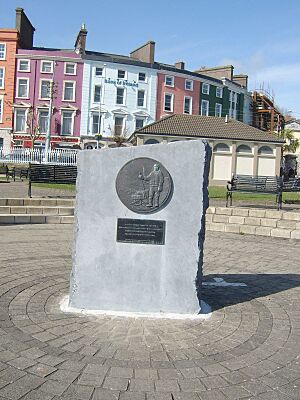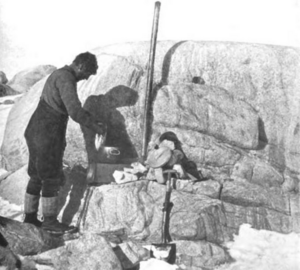Robert Forde facts for kids
Robert Forde (born August 29, 1875 – died March 13, 1959) was an Antarctic explorer. He was a member of the famous Terra Nova Expedition led by Captain Robert Falcon Scott from 1910 to 1912. This journey explored the icy lands of Antarctica.
Contents
Robert Forde was born in a small village called Moviddy, near Bandon in Ireland. His parents were George and Charity Forde. Robert was the youngest of three children.
When he was 16 years old in 1891, Robert joined the Royal Navy. He worked very hard and rose to the rank of Petty Officer 1st Class. In 1910, at 35 years old, he volunteered for Captain Robert Falcon Scott's second trip to Antarctica. This was known as the British Antarctic [Terra Nova] Expedition. Robert Forde was one of several Irishmen on the expedition, including Tom Crean and Patrick Keohane.
Exploring the Antarctic
Robert Forde took part in important journeys to set up supply points for the expedition. These supply points, called "depots," held food and equipment for the explorers. In 1911, he was a "sledge master" during a journey with Griffith Taylor. This meant he was in charge of the sledges, which are like large sleighs used to carry supplies over snow and ice.
The Terra Nova expedition explored a large part of Antarctica from 1911 to 1913. Forde and his team were responsible for studying the area around Ross Island and the high, flat land called the Polar Plateau. Because of his work, a glacier in Antarctica is named Mount Forde after him.
During his time in Antarctica, the temperatures were incredibly cold, dropping to -62 degrees Celsius. Robert Forde suffered severe frostbite on his hands. By March 1912, his hands were so badly hurt that Captain Scott ordered him to return home. He was taken back to New Zealand in April 1912. Because of this, he could not join the final journey to the South Pole, which sadly ended with Captain Scott and his team losing their lives. Captain Scott wrote in his diary that he missed Forde, saying "no one who could replace him."
When Robert Forde returned home, he continued to serve in the Royal Navy during World War I. He was promoted to Chief Petty Officer. He stayed in the Royal Navy until 1920, when he moved back to Cobh, County Cork, in Ireland. For the rest of his life, he wore a glove to protect his hand from the effects of the frostbite he had suffered in Antarctica.
The Terra Nova Expedition Journey
The Terra Nova ship left Cardiff, Wales, on June 15, 1910. About 8,000 people had wanted to join this expedition! The ship sailed to New Zealand, stopping at places like Cape Town along the way. On November 19, 1910, they picked up more supplies and expedition members in New Zealand.
After facing bad storms and thick ice, the ship reached Ross Island in Antarctica on January 4, 1911. A group of 34 explorers stayed on shore for two seasons, exploring Ross Island and the surrounding areas. They set up their main base at Cape Evans. During the unloading of supplies, one of the expedition's experimental motor sledges fell through the sea ice and was lost.
The Terra Nova ship then left on January 26, carrying two smaller teams. One team of four went to the Victoria Land mountains, and another team of six went to the east. The Victoria Land team included geologists and a physicist. A geologist is a scientist who studies the Earth's rocks, land, and how it has changed over time. This team studied the geology and glaciers in the area.
The Terra Nova left Cape Evans with the remaining expedition members on January 19, 1913. They picked up the samples collected by the Victoria Land team and sailed back to New Zealand. They arrived on February 10, 1913, and shared the sad news of Captain Scott's death.
Robert Forde and Captain Scott
Captain Robert Falcon Scott, often called 'The Skipper' by his crew, was the leader of the Terra Nova Expedition. During the journey, Captain Scott wrote many diaries about their experiences in Antarctica. These diaries were later published in 1913 as "Scott's Expedition."
In January 1912, Captain Scott and his remaining team reached the South Pole. They had traveled for 93 days and covered about 960 miles. Sadly, Captain Scott and his team died on their way back from the expedition due to starvation and the extreme cold. Their bodies were found eight months later.
Later Life and Legacy
After the Terra Nova expedition, Robert Forde was promoted to Chief Petty Officer. He served on several British ships during World War I. After the war, he retired and returned to Cobh, Ireland.
In June 1949, Robert Forde attended the film premiere of Scott of the Antarctic in Cork. He went with Ellen Crean, who was the wife of his former Terra Nova teammate, Tom Crean. Robert Forde passed away in Cobh in March 1959.
Robert Forde is remembered in Antarctica by the naming of Mount Forde. This is a large mountain over 1,200 meters high in Victoria Land, Antarctica. He is buried at the Clonmel Old Church Cemetery in Cobh, County Cork. In March 2009, on the 50th anniversary of his death, a memorial was unveiled in Cobh to honor him. It is a granite stone with a bronze plaque showing Forde with his sledge. Another plaque was also placed at 52 Harbour Row, Cobh, where he lived.
Images for kids





